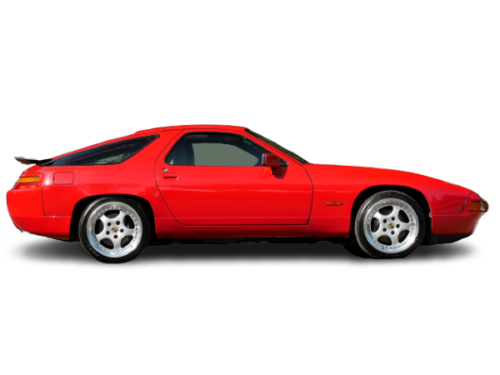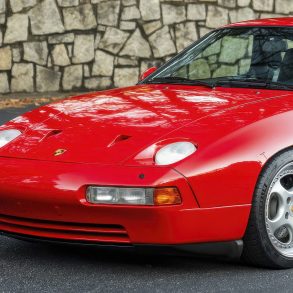(1989 – 1991) Porsche 928 GT – Ultimate Guide
In 1989, 928 buyers had the choice of the S4 or the GT, a better-equipped, manual-only car. The 928 GT was sportier than the 928 S4. Thanks to various modifications, its power unit generated up to 330 hp. The GT was delivered as standard without side protection strips and with wheels in a unique design. It featured a dogleg manual gearbox, a more aggressive suspension, and special seven-spoke Club Sport wheels. The S4 and GT variants halted production at the end of the 1991 model year, making way for the final version of the 928, the Porsche 928 GTS.
The Porsche 928 GT
In February of 1989, Porsche introduced a sportier variant called the 928 GT. Porsche debuted the 928 GT in the late winter 1988/89 after dropping the slow-selling CS and SE version. In terms of equipment, the GT weighed less than a 928 S4. The GT was like the 928 SE, having more equipment than a Club Sport model but less than a 928 S4 to keep the weight down somewhat. It had the ZF 40% limited-slip differential as standard equipment and was only available with a manual (dogleg) gearbox.
European 1989 CS and GT wheels had an RDK tire pressure monitoring system as standard, which was also optional for the same year S4. For 1990 model year Porsche made RDK and a 0-100% variable ratio limited-slip called PSD (Porsche Sperr Differential) standard in both GT and S4 models for all markets. This system is much like the one from the flagship 959 and gives the vehicle even more grip on the track.
Car and Driver found the 1991 edition needed no defense, even though nomenclature was about the only thing that had changed. “GT” now denoted the manual model, and a revived “S4” tag identified the automatic version. Granted, editor Art St. Antoine took note of the 928’s “reputation as something of a poseur’s Porsche — a car seen less often carving up mountain roads than being proudly handed over to the country-club valet.” But he then promptly declared the GT “a deadly serious driver’s car. In its quest for pure performance, Porsche has chiseled off most of the 928’s remaining soft edges.” He almost sounded surprised, but then with the 928’s slower development pace, C/D (and some other “buff books”) hadn’t visited the car in a while.
No matter. As usual with Porsches, the numbers spoke volumes. Despite absolutely carryover specifications — and R&T’s 1990 numbers — C/D’s GT rocketed “from 0 to 60 mph in just 5.2 seconds and through the quarter-mile in 13.7 seconds at 104 mph — improvements of 0.1 and 0.2 second, respectively, over . . . the five-speed 928S4 we tested in May 1987. Top speed is up a full 10 mph to 169 mph at the engine’s 6600-rpm redline.”
And road manners were better than ever. The GT “shines when you give it the spurs,” St. Antoine reported. “The control efforts are finely honed for speeds above 80 mph; the steering arcs with reassuring heft, the shifter chunks solidly through its racing-pattern H, and the clutch takeup is smooth and positive. Spin the speedo to autobahn speeds and the GT really comes into its own. Suddenly, the beefy body feels not chubby but secure [and the car] is far more agile in curvy-road dicing and slicing than you’d expect. . . . Porsche has tamed the old 928’s tail-happiness; the GT understeers resolutely through hard bends, tucking in neatly even if you suddenly snap off the throttle.”
Yet for all that, St. Antoine judged the 928GT too potent and pricey for all but “the serious” and “the solvent.” Then again, “Porsche plans to sell only about 100…in the U.S. this year. That should tell you plenty about this car’s mass-market appeal.” However limited the supply, the 928’s appeal was still on the wane. Porsche Cars North America (PCNA) moved just 620 of the 1990 models and a mere 262 of the ’91s (including, one presumes, those 100 GTs). Though total production took an uptick to 5,238 for calendar year 1991, it dropped back to 3,389 in ’92, when U.S. sales were a minuscule 181.
The GT ended production at the end of the 1991 model year, making way for the final version of the 928, the Porsche 928 GTS.
Evolution of the 928 GT
1989 Porsche 928 GT
- Porsche 928 GT introduced as a late model year addition (It appears that the 928 S4 5M was still built during 89 GT production. It is critical that claims of a 1989 928 GT be verified both visually and with option codes)
- 1989 928 GT production begins in March 1989 and ends in June 1989
- The earliest 1989 928 GT currently recorded has a VIN of 1107
- 1989 928 GT power increased to 326 bhp & 317 ft/lbs
- 1989 928 GT is differentiated from the 928 S4 in the following ways:
- Rolled fender lips front and rear
- Lightened twin outlet exhaust
- Shorter shift lever
- Different intake (same as GTS)
- GT camshafts
- 17 mm Rear wheel spacers
- Short ratio manual transmission
- Wheels were 8×16(front) and 9×16(rear) “club sport” with an offset of 60mm with 225/50 16(front) and 245/45 16(rear) tires
1990 Porsche 928 GT
- Base MSRP up to: $74,545 + $1,300 gas guzzler tax
- 928 GT(5-speed) power remains at 326 bhp & 317 ft/lbs while 928 S4(automatic) stays at 316 bhp & 317 ft/lbs
- Dual airbags appear in the 928 for the first time
- Tire pressure monitoring system (RDK)
- 928s with 5-speed are now GTs
- Design 90 style wheel introduced on the 928 (flat disk style wheels still available)
- Electronically controlled limited-slip differential (PSD) on all models
- Twin outlet muffler on both S4 and GT
- Wheels were 7×16 front and 8×16 rear flat disc with an offset of 65mm(front) and 52.3mm(rear) with 225/50 16(front) and 245/45 16(rear) tires
- Standard on 1990 and 1991 928 GTs and optional on S4s were 7×16(front) and 8×16(rear) “Design 90” style wheels with an offset of 65mm(front) and 52.3mm(rear) with 225/50 16(front) and 245/45 16(rear) tires
- VIN tags on all body panels eliminated
1991 Porsche 928 GT
- Shorter more ergonomic shift lever in the 91 928 GT
- Cooling flaps in front of radiator eliminated
- Improved door seals to reduce water dripping on occupants during rainy weather






